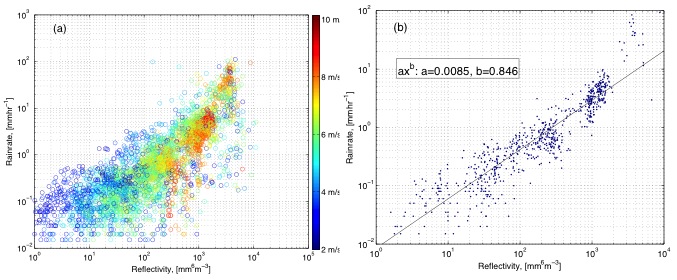Automated Rain Rate Estimates Using the Ka-band ARM Zenith Radar (KAZR)
Submitter:
Chandra, Arunchandra Susheela — McGill University
Area of research:
Radiation Processes
Journal Reference:
Science
The use of millimeter wavelength radars for probing precipitation has recently gained interest. However, estimation of precipitation variables is not straightforward due to strong attenuation, radar receiver saturation, antenna wet radome effects, and natural microphysical variability. Here, an automated algorithm is developed for routinely retrieving rain rates from profiling Ka-band (35-GHz) ARM zenith radars (KAZR). A 1-D simple, steady state microphysical model is used to estimate the impact of microphysical processes and attenuation on the profiles of the radar observables at 35-GHz, thus providing criteria for identifying when attenuation or microphysical processes dominate KAZR observations. KAZR observations are also screened for saturation and wet radome effects.
Impact
The proposed algorithm uses two different methods for estimating the rainfall rate: 1) for high rain rates (DV>5ms-1), the A-R relationship is applied. 2) For lower rain rates (DV<5ms-1), the Ze-R relationship is applied. A 1-D microphysical model that accounts for the microphysical processes of accretion and evaporation, and radar attenuation due to liquid, is used to infer the criteria for determining if microphysics or attenuation controls the observed KAZR profiles of radar reflectivity. Observations collected by the KAZR, disdrometer, and scanning weather radars during the Dynamics of the Madden-Julian Oscillation (DYNAMO)/ARM MJO Investigation Experiment (AMIE) field campaigns at Gan Island, in the tropical Indian Ocean, are used to validate the proposed approach. The results indicate that the proposed algorithm can be used to derive robust statistics of rain rates in the tropics from KAZR observations.
Summary
An automated algorithm is developed to retrieve rain rates from profiling Ka-band observations. To the best knowledge of the authors, this is the first attempt to extend KAZR observations for routine rain rate retrieval. The algorithm is applicable to the KAZRs of the ARM program and the MIRA-36 Ka-band radars deployed at several research institutions in Europe.
The proposed algorithm is applied to four months of KAZR observations collected during the deployment of the ARM Mobile Facility in the context of the DYNAMO/AMIE field campaign. The KAZR retrieved rain rates are compared with the nearby surface rain gauge and disdrometer measurements. The comparison shows a good agreement with the correlation coefficient of 0.63.
The statistics of the Ka-band retrieved rain rates are compared to those derived from the S-PolKa and SMART-R data. The observations are decomposed to stratiform and convective rain events. The shape of the histograms between different radars is consistent with each other and with the previous studies. The present study sets a framework for retrieving rainfall rates from Ka-band radars using an algorithm with a physical basis. This algorithm will be applied to retrieve rain rates at the other ARM sites to study shallow to deep convection transitions and related microphysical processes.


